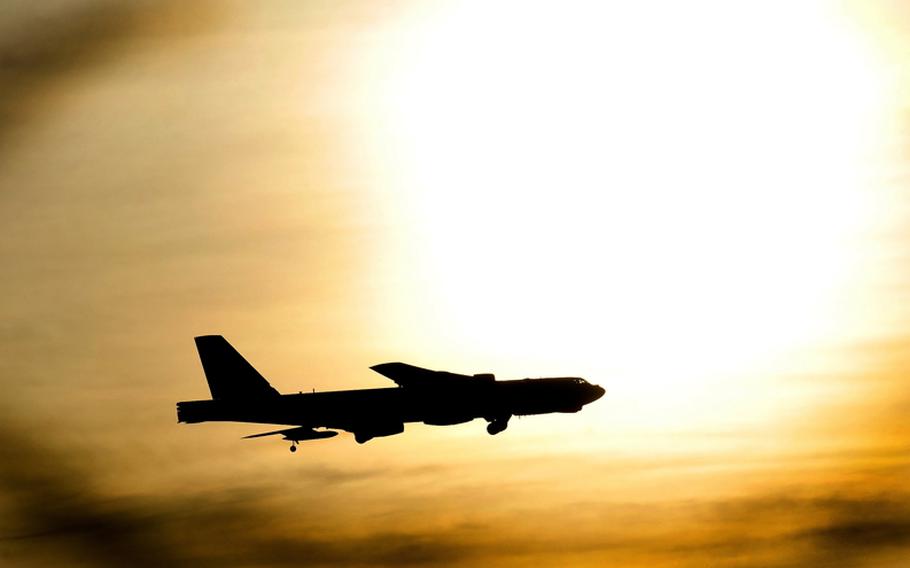
A B-52 Stratofortress flies just under the sun after flying a routine sortie at Minot Air Force Base, N.D. on Nov. 20, 2012. (Andrew Crawford/Courtesy U.S. Air Force)
A front-page headline on this report in March 20 print editions of Stars and Stripes incorrectly stated that nuclear-armed B-52s are taking part in the current U.S.-South Korea military exercises. As the report correctly explains, the B-52s are capable of carrying nuclear weapons, but the Defense Department has not stated that they are actually carrying nuclear arms.
SEOUL — The Pentagon says nuclear-capable B-52 bombers are taking part in joint U.S.-South Korean military exercises this month, a measure apparently aimed at dissuading North Korea from conducting future provocations.
The question is whether the move may discourage North Korea or provoke the rogue state at a time when it is riding a wave of success — its third nuclear weapons test and the launch of a three-stage rocket — and making threats to turn Seoul and Washington D.C. into a “sea of fire.”
Speculation has been widespread that the North may undertake some kind of provocation after the current exercises end as a test for South Korea’s new president.
China warned Monday that plans to bolster American missile defense systems in South Korea, Japan and Alaska could antagonize Pyongyang, which has bristled against new U.N. sanctions and called the joint exercises preparation for an attack on the North. It also said last week that it considers invalid the armistice that effectively ended the Korean War.
B-52 bombers based at Andersen Air Force Base in Guam flew a mission over South Korea on March 8 as part of the Foal Eagle exercise, a Department of Defense statement said Monday.
Hours earlier in Seoul, Deputy Secretary of Defense Ashton Carter told reporters a B-52 flight was scheduled for Tuesday. He offered no details but described the flight as “routine.”
Carter promised that deep cuts in the U.S. defense budget will not affect its rebalance to the Asia-Pacific region or the military’s operations in South Korea.
“We remain steadfast to our commitment to the extended deterrence offered by the U.S nuclear umbrella and we will ensure that all of its capabilities remain available to the alliance,” he said.
While new Defense Secretary Chuck Hagel ordered Pentagon leaders Monday to review the viability of the Asia-centric military strategy released last year, he has seemed to be on board with the concept since he was sworn in.
Pentagon press secretary George Little on Monday called the B-52 flight “a stepped-up training effort” to demonstrate U.S. resolve and promote peace on the peninsula.
“It’s not any secret that we are in the midst of sending a very strong signal that we have a firm commitment to the alliance with our South Korean allies,” he said.
The U.S. and South Korea are taking part in the annual Foal Eagle and Key Resolve war games, set respectively for March 1-April 30 and March 11-21.
The B-52 Stratofortress can perform missions that included carrying nuclear weapons and precision-guided missiles.
7th Air Force did not immediately comment on the B-52 flights. A spokesman for the Ministry of National Defense would not comment on details about the strategic bomber’s involvement in the exercises, but called it an “important means for keeping peace on the Korean peninsula in the face of North Korea’s nuclear threat.”
Stars and Stripes’ Yoo Kyong Chang contributed to this report.